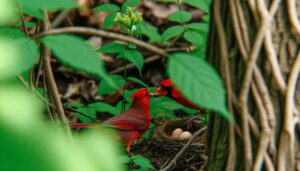Do Cardinals in Michigan Fly South for Winter?
Cardinals in Michigan don't fly south for the winter. These non-migratory birds stay within a few miles of their birthplace all year.
They cope with harsh winters by fluffing their feathers to trap heat and changing their diet to seeds and berries. You'll notice them roosting in dense shrubs or evergreen trees for shelter.
Their behavior includes shivering to generate extra warmth. Food is a high-energy priority, so expect to see them at feeders stocked with sunflower seeds.
Finally, their seasonal adaptations and strategies are fascinating, revealing much about how they thrive despite Michigan's frigid conditions.
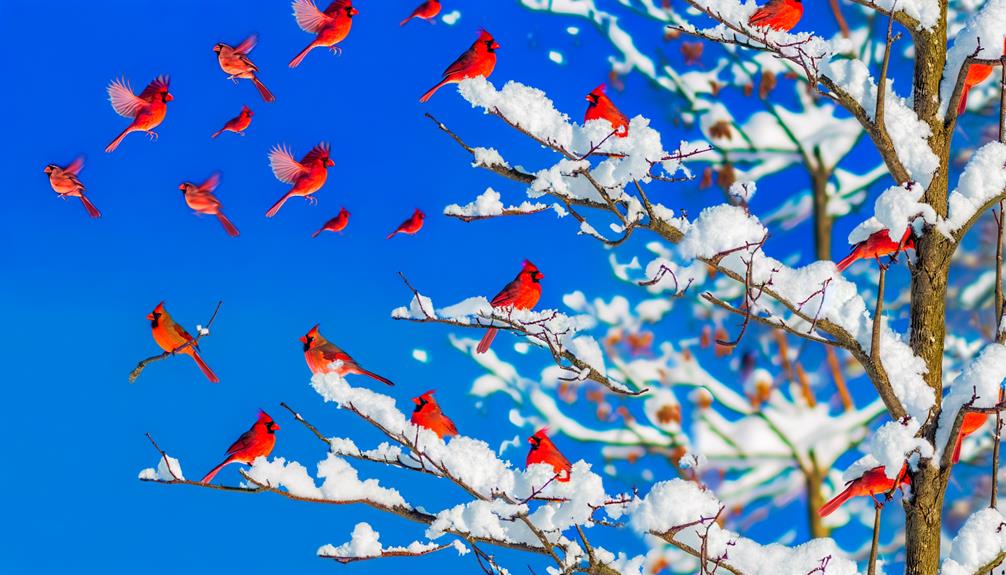
Key Takeaways
- Cardinals in Michigan do not migrate south for the winter.
- They remain in Michigan year-round, staying close to their birthplace.
- Cardinals are non-migratory birds and endure harsh winters through various adaptations.
- They fluff their feathers and roost in dense shrubs for warmth.
- Cardinals shift their diet to seeds and berries during winter months.
Cardinal Migration Myths
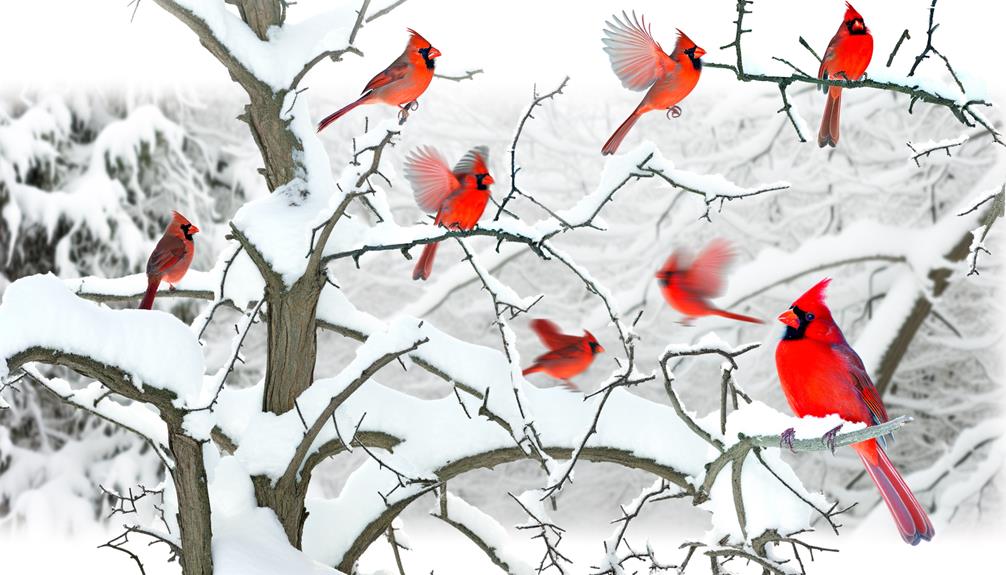
Contrary to popular belief, cardinals in Michigan don't migrate south for the winter, debunking a common myth about their seasonal behavior. You might notice these brilliant red birds year-round, a reflection of their adaptability.
Unlike many migratory species, cardinals are non-migratory, staying within a few miles of their birthplace throughout their lives. Their physiological and behavioral traits equip them to endure Michigan's harsh winters. Observing cardinals through the colder months offers insights into their resourcefulness and resilience.
These birds rely on abundant food sources and natural shelters to withstand low temperatures. By staying put, cardinals maintain territorial claims, ensuring a steady supply of resources. Understanding this behavior underscores the cardinals' unique adaptation strategies and challenges common misconceptions.
Winter Adaptations
You'll notice that cardinals have developed remarkable adaptations to survive Michigan's severe winters.
They manage cold weather by fluffing their feathers to trap heat, and they efficiently handle food resources by shifting their diet to available seeds and berries.
For shelter, cardinals roost in dense shrubs and evergreen trees, providing vital protection against the elements.
Cold Weather Survival
Cardinals in Michigan employ several fascinating adaptations to endure the harsh winter months, ensuring their survival despite the frigid temperatures.
You'll notice that their plumage becomes denser as they grow extra feathers to provide insulation. These birds fluff up their feathers, creating air pockets that trap body heat.
Additionally, they seek shelter in dense shrubs or evergreen trees to escape the wind. Cardinals also exhibit a unique shivering behavior, which generates heat through muscle contractions.
Their circulatory system further aids in cold weather survival by minimizing heat loss; blood vessels constrict to reduce blood flow to extremities, conserving warmth in their core.
These remarkable adaptations illustrate how cardinals thrive without migrating, embracing the freedom to remain in their native habitat.
Food Resource Management
During the winter months, careful food resource management becomes essential for the survival of Michigan's cardinals. You'll notice these birds shifting their foraging habits, focusing on high-energy foods like seeds and nuts. They often visit bird feeders stocked with sunflower seeds, safflower seeds, and suet.
By caching food in secure locations, they secure a reliable supply during scarce periods. You might observe them meticulously selecting and storing seeds under leaf litter or in tree crevices. This strategic behavior minimizes energy expenditure and maximizes caloric intake.
Cardinals also exhibit flocking behavior, which aids in locating food sources quickly. By understanding these adaptive strategies, you'll appreciate how cardinals maintain their resilience and independence despite the harsh winter conditions.
Shelter and Roosting
In the harsh Michigan winter, these vibrant birds display remarkable adjustments, seeking out dense shrubs and evergreen trees to provide essential shelter and roosting sites.
You'll notice cardinals preferring evergreens like pines and spruces, where thick foliage offers insulation against biting winds and snow. They often roost in small groups, maximizing body heat by huddling together.
When you observe them, you'll see how they carefully choose locations that face away from prevailing winds, minimizing exposure. Cardinals also utilize brush piles and thickets, which serve as natural windbreaks and hiding spots from predators.
Food Sources
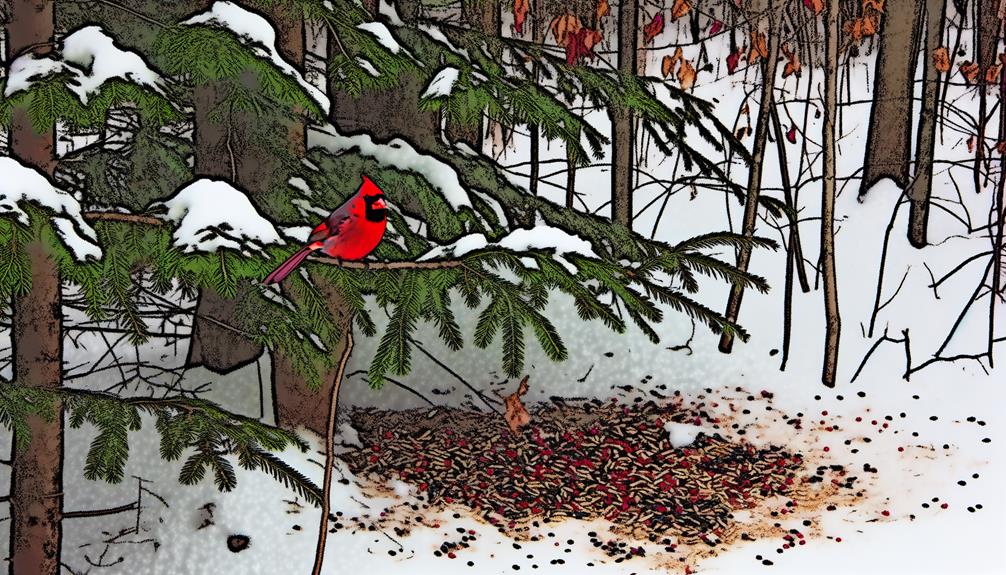
You'll notice cardinals rely heavily on winter food availability to survive the cold months.
Observing their behavior, you can see the significant role bird feeders play in supplementing their diet.
Winter Food Availability
Have you ever wondered how cardinals manage to find enough food during Michigan's harsh winters? Cardinals adapt by foraging for various available food sources. They consume seeds from coniferous trees, like pine and spruce, which remain accessible even under snow.
You'll also notice them eating berries from shrubs such as holly and sumac. These vibrant birds possess strong bills designed to crack open tough seeds and nuts, making them versatile feeders. By observing their behavior, you'll see cardinals meticulously scouring the ground for fallen seeds and insects.
Adaptability is their strength; their keen eyesight helps them locate hidden food resources. So, despite the cold, cardinals thrive by tapping into Michigan's diverse winter bounty.
Bird Feeder Benefits
Setting up a bird feeder in your yard provides cardinals with a reliable source of food during Michigan's icy winter months. It ensures they've access to high-energy seeds like sunflower and safflower, which are vital for their survival.
Observational studies show that cardinals visit feeders more frequently during colder periods when natural food sources become limited. By maintaining a bird feeder, you're not only supporting these colorful birds but also deepening your own connection to nature. It's a simple way to observe their behavior and admire their resilience.
Scientifically, feeders can help increase local cardinal populations by reducing winter mortality rates. This small action empowers you to make a tangible impact on your local ecosystem, promoting biodiversity and providing freedom for these splendid creatures.
Shelter and Nesting
In Michigan, cardinals often seek shelter in dense shrubs and evergreen trees, where they can construct their nests using twigs, leaves, and grass. You'll notice they prefer foliage with thick coverage, providing protection from harsh winter winds and predators.
Cardinals build their nests at varied heights, typically ranging from 1 to 15 feet off the ground. Females primarily handle nest construction, weaving materials meticulously to create a sturdy structure. During colder months, they don't abandon these habitats but instead reinforce and maintain their nests.
Social Behavior
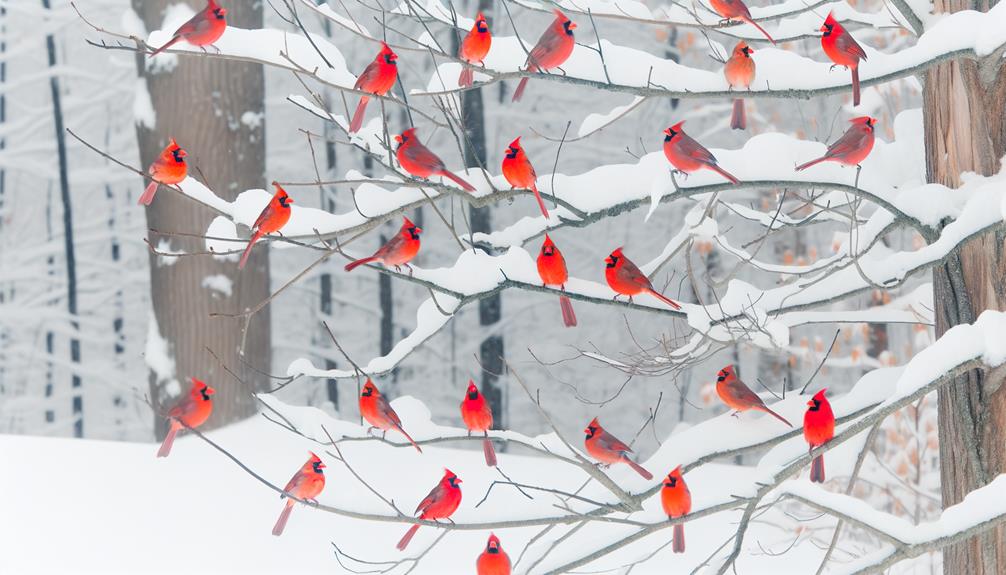
Cardinals exhibit a fascinating range of social behaviors, often forming monogamous pairs that communicate through a series of distinctive calls and songs. You'll notice how they use these vocalizations to establish territories and strengthen pair bonds.
Males sing more frequently to attract mates and ward off rivals. During breeding season, both partners engage in mutual preening, a behavior that reinforces their bond. You might observe them feeding each other, a practice known as mate-feeding, which plays a pivotal role in their relationship.
In winter, cardinals often join mixed-species flocks, enhancing their foraging efficiency and predator vigilance. This social adaptability helps them thrive in Michigan's diverse environments, making their interactions both intricate and essential for survival.
Predators and Threats
You might be surprised to learn that a variety of predators, from domestic cats to larger birds of prey, pose significant threats to cardinals in Michigan. These vibrant birds face dangers that can impact their survival rates throughout the year.
Predators include:
- Domestic cats: Often roam freely and hunt cardinals.
- Hawks: Particularly sharp-shinned and Cooper's hawks, adept at snatching birds mid-flight.
- Owls: Nocturnal hunters that target cardinals roosting at night.
- Snakes: Can raid nests, consuming eggs and fledglings.
- Squirrels: Known to steal eggs from nests.
Understanding these threats helps you appreciate the challenges cardinals endure. Their vivid presence in Michigan's landscape is a tribute to their resilience, intricately woven into the delicate balance of the ecosystem.
Backyard Birdwatching Tips
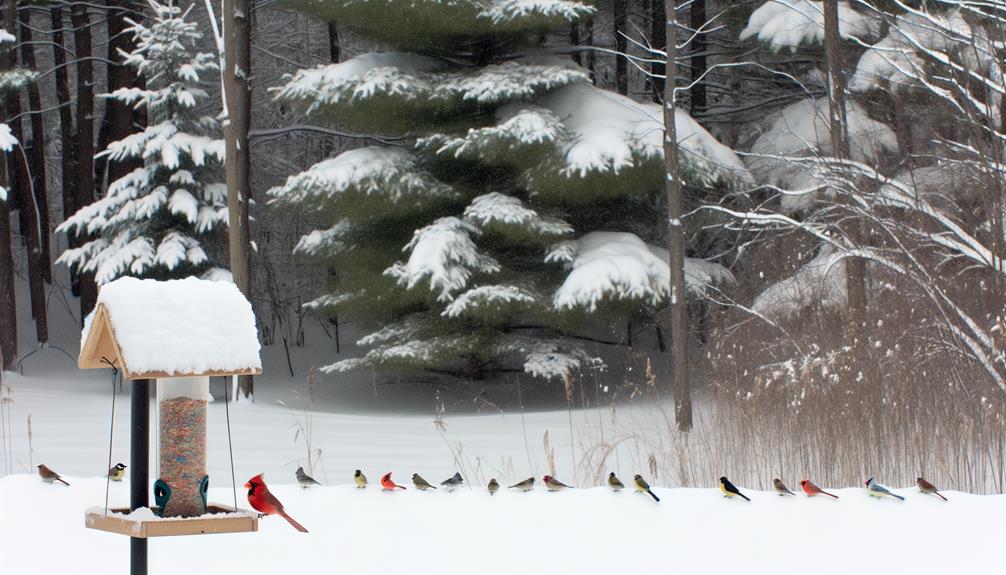
To attract cardinals to your yard, provide a variety of native plants that offer both food and shelter. Select shrubs like dogwood and serviceberry, which produce berries cardinals favor. Include dense evergreens for nesting and protection.
Install a bird feeder with sunflower seeds, safflower seeds, and peanuts. Guarantee fresh water is available year-round; a heated birdbath prevents freezing in winter.
Place feeders and plants strategically to create safe, accessible feeding zones. Regularly clean feeders to prevent disease. Observe quietly from a distance to avoid startling them.
Track their visits and behaviors; this enhances your birdwatching experience. By creating a cardinal-friendly environment, you'll enjoy their vibrant presence, adding beauty and life to your backyard throughout the year.
Importance to Ecosystem
By acting as both seed dispersers and insect controllers, these vibrant birds play an important role in maintaining the balance of local ecosystems. You'll appreciate how cardinals contribute to:
- Seed dispersal: They help propagate various plant species by consuming and excreting seeds.
- Insect control: Their diet includes many insects, reducing pest populations naturally.
- Pollination: Occasionally, they assist in pollinating flowers while feeding.
- Nutrient cycling: By breaking down organic matter, they aid in nutrient distribution.
- Ecosystem diversity: Their presence supports a wide range of species interactions.
Observing cardinals, you'll notice their activities sustain the intricate web of life.
Your understanding of their ecological importance will deepen your appreciation for these resilient birds and their vital role in Michigan's environment.
Conclusion
In understanding Michigan cardinals, you'll see they're like winter warriors, adapting instead of migrating. They find food, create shelters, and maintain social ties, thriving in the cold. Predators and threats are just part of their battleground.
By observing these vibrant birds, you contribute to their ecosystem, witnessing nature's resilience firsthand. So, keep your feeders full—you're not just feeding birds; you're nurturing a complex, beautiful web of life.





